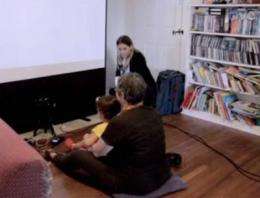Video-based test to study language development in toddlers and children with autism

Parents often wonder how much of the world their young children really understand. Though typically developing children are not able to speak or point to objects on command until they are between eighteen months and two years old, they do provide clues that they understand language as early as the age of one. These clues provide a point of measurement for psychologists interested in language comprehension of toddlers and young children with autism, as demonstrated in a new video-article published in JoVE (Journal of Visualized Experiments).
In the assessment, psychologists track a child's eye movements while they are watching two side by side videos. Children who understand language are more likely to look at the video that the audio corresponds to. This way, language comprehension is tested by attention, not by asking the child to respond or point something out. Furthermore, all assessments can be conducted in the child's home, using mobile, commercially available equipment. The technique was developed in the laboratory of Dr. Letitia Naigles, and is known as a portable intermodal preferential looking assessment (IPL).
"When I started working with children with autism, I realized that they have similar issues with strangers that very young typical children do," Dr. Naigles tells us. "Children with autism may understand more than they can show because they are not socially inclined and find social interaction aversive and challenging." Dr. Naigles' approach helps make this assessment more valuable. By testing the child in the home, where they are comfortable, Dr. Naigles removes much of the anxiety associated with a new environment that may skew results.
While this technique identifies some similarities between typically developing toddlers and children with autism spectrum disorder, such as understanding some types of sentences before they produce them, this does not mean that these children are the same. "Some strategies of word learning that typical children have acquired are not demonstrated in children with autism." Dr. Naigles says. By illuminating both strengths and weaknesses, the test is valuable for assessing language development. "JoVE is useful because in the past, I have gone to visit various labs to coach them in putting together an IPL. JoVE will enable other labs to set up the procedure more efficiently." JoVE associate editor Allison Diamond stated, "Showing this work in a video format will allow other scientists in the field to quickly adapt Dr. Naigles' technique, and use it to address the question of language development in autism, an extremely important field of research."
More information: www.jove.com/video/4331/portab … vestigating-language















